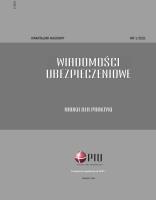Pisemność oświadczenia a forma pisemna w rozumieniu art. 78 § 1 k.c. na przykładzie art. 21 ust. 4 ustawy o działalności ubezpieczeniowej i reasekuracyjnej
the written form of the statement versus the written form within the meaning of article 78 § 1 of the civil code based on the example of article 21 (4) of the Insurance and Reinsurance Act
Author(s): Michał Romanowski, Katarzyna ZarzyckaSubject(s): Law, Constitution, Jurisprudence
Published by: Polska Izba Ubezpieczeń
Keywords: written form; writtenness; forms of declarations of intent; authorization tools; document
Summary/Abstract: The essence of the legal problem discussed in this article boils down to determining, on the example of Article 21 (4) of the u.dz.u.r., inter alia, whether each time the law refers to making a statement “in writing”, a “written declaration” or a “written request” it should always be understood as a “written form” of a legal action referred to in Article 78 § 1 of the Civil Code. This (incorrect) position seems to be taken by the Financial Supervision Commission. The diversity of terminology and the related doubts about the interpretation of the provisions regarding the form of a legal action cause problems for insurance companies in their relations with the Financial Supervision Authority, for which a “written statement” is the same as a “statement made in written form”. The FSC’s position seriously obstructs the practice, cost and safety of insurers, and is not supported by customer protection. It is astonishing in the digital age, let alone COVID-19. If it can be assumed that the requirements indicated in Article 78 § 1 of the Civil Code do not apply to the statements and demands referred to in Article 21 (4) of the u.dz.u.r., then automatically there will be a wider field for a more flexible assessment of the factual requirements for such a form. This will mean that while maintaining certain – necessary from the point of view of the purpose of the above- mentioned provision and customer protection – technical requirements as to electronic documents, it will be possible to effectively make statements in a form other than the traditional written form (un- derstood as putting a handwritten signature on paper).
Journal: Wiadomości Ubezpieczeniowe
- Issue Year: 2021
- Issue No: 1
- Page Range: 3-14
- Page Count: 12
- Language: Polish

